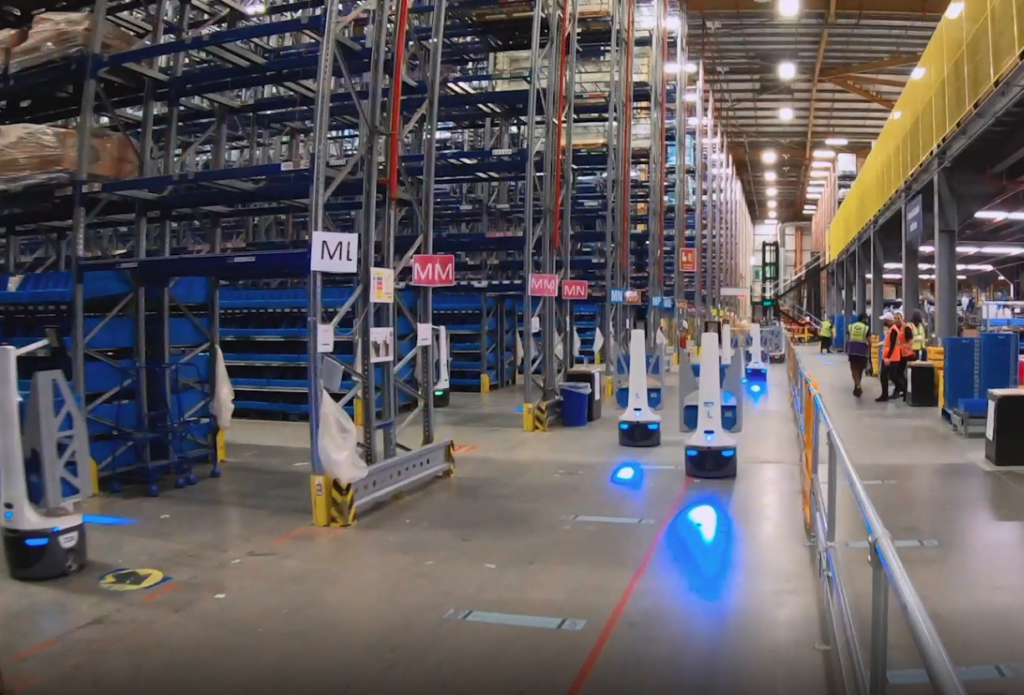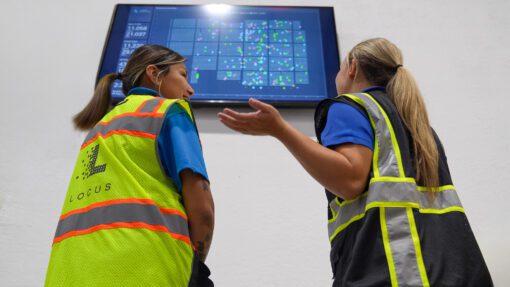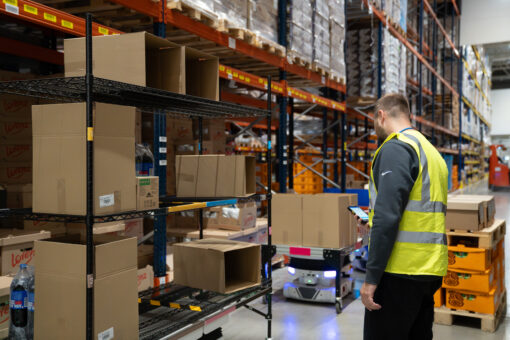WP: How to achieve 400 UPH with Locus Fast Pick
WP: How to achieve 400 UPH with Locus Fast Pick Download Now!
AMR vs AGV: A Clear Choice for Flexible Material Handling
Jason Walker, VP, Market Development

As automation becomes the new normal for manufacturing and warehouse operations in the age of Industry 4.0, the options to help you get there are rapidly evolving. Technologies like unmanned forklifts, collaborative robot arms, enhanced sorting/picking, and smart conveyors are advancing while costs continue to decrease, making these options more accessible for companies of all sizes for increased efficiency, increased production and reduced labor costs.
One advancement that has attracted much attention is the advent of Autonomous Mobile Robots (AMRs) as smarter, more flexible alternatives to Automated Guided Vehicles (AGVs) for a wide variety of material handling activities. If you are considering agv/amr material handling to streamline your operations, it first helps to understand the difference between these two automation alternatives.
What is an AGV: AGV Meaning
An Automated Guided Vehicle, or AGV, is an industrial vehicle that can be pre-programmed to transport goods in a warehouse or manufacturing environment. AGV stands for automated guided vehicle.
Features of an AGV:
- Navigation: Traditionally agv warehouse bots are guided by magnetic strips or wires installed on or under a warehouse floor
- Deployment: AGv robotics require installation of navigation guides, and sometimes requiring substantial facility renovation
- Operational Flexibility: Altering AGV operating patterns requires repeating the entire deployment process.
- Responsiveness: AGV material handling has limited flexibility to adapt to changing environment or changing workflow
What is an AMR: AMR Robot Meaning
An Autonomous Mobile Robot, or AMR, is a vehicle that uses on-board sensors and processors to autonomously move materials without the need for physical guides or markers. It learns its environment, remembers its location, and dynamically plans its own path from one waypoint (a location or destination within the environment) to another. AMR warehouse solutions offer numerous benefits.
Features of an AMR:
- Navigation: Using AMR technology such as LiDAR sensors & Simultaneous Localization and Mapping (SLAM), an AMR will determine the best route between waypoints
- Deployment: This can vary, but great AMRs can be unboxed and put to work in less than 15 minutes
- Operational Flexibility: It will dynamically plan the shortest path based on current conditions and requirements, if the work changes from one day to the next, the AMR’s route will change with it
- Responsiveness: AMRs will automatically sense and avoid obstacles and blocked paths to find the best route to its next waypoint
Cost Considerations
When weighing AGv vs AMR, it may be tempting to lean towards a solution with a lower price point. However, there are other factors that will impact the overall cost of autonomous material handling, and the potential return on investment for your company and production line.
AGV
While warehouse AGVs typically cost less per robot than AMRs, you must also consider the costs you will incur to set up, deploy, reconfigure, and operate them. AGVs usually require the installation of physical guides, under-floor wiring, or surface tape to allow the AGV to navigate and locate itself in its surroundings. And if you need to install sensors as a guidance system (magnetic tape) beneath the floor, that means lost hours to renovation, plus the cost of the actual work.
Once you’ve prepared your physical environment, you must deploy the AGV into your operation with a predetermined path that is based on the work being done at the time. The AGV will run on a set course unable to move around unexpected obstacles that get in its way. Oftentimes, the AGV will stop completely until the path is fully cleared. And if your environment changes or the work changes, you will incur additional costs to reconfigure your system and repeat the deployment process.
AMR
In contrast, a great warehouse AMR requires no alterations to your current facility and can autonomously navigate through manufacturing and warehouse spaces. It learns its environment, remembers its location, and dynamically plans its own path from one destination to another. If its path is blocked, an AMR can reroute itself with no assistance.
The sensors an AMR uses to navigate ensure that it can operate safely in a dynamic environment alongside humans and material handling equipment. And because an AMR is not a permanent structure in the facility, it can be moved and re-deployed with minimal cost as your business grows and changes over time. In fact, an AMR can work in one part of the facility in the morning and be deployed for a completely different task later in the day.
AMR AGV: Which Should You Choose?
AGV – Useful but Limited
If your company rarely changes, in terms of products produced, operational workflow, or in your workforce, then an AGV may be a good fit. However, if you’re in the majority of manufacturers and warehouses that see rapid changes in their material flow, workstations, or product mix, all of that change demands a smarter robot that can change with you.
AMR – Advanced, Flexible, Accessible
AMRs are collaborative and flexible to keep up with future opportunities that come to manufacturing and warehouse operations. They can avoid obstacles and unburden workers from repetitive or back-breaking work so these workers can focus on more valuable and fulfilling jobs.
Most importantly, AMR warehouse automation is easy to set up and use enable immediate ROI. If workers are able to unbox and start using an AMR automation in less than 15 minutes, without a roboticist needed to install it; then they are empowered to use these tools with confidence and take pride in making their companies more efficient and competitive.
Flexibility, advanced navigation, ease of deployment, plus a wide range of applications make AMRs the perfect solution to get you started in automating your dynamic operations and empowering your valued workforce who are on the job today. Interested in learning more about our easy to use, industrial-strength AMR manufacturing or AMR logistics solutions?
About the Author
Jason has over 20 years of robotics leadership roles that range from managing QA and testing for iRobot’s Roomba to co-founding CyPhy Works, a revolutionary tethered drone company. Most recently, Jason was Co-founder and CEO of Waypoint Robotics, a leading provider of heavy payload capacity, omnidirectional AMRs, that was acquired by Locus in 2021. Jason is a life-long roboticist and has won many awards, accolades, and patents for various robot-related technologies. Jason is using his vast knowledge and experience to propel Locus into new opportunities.




